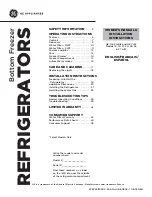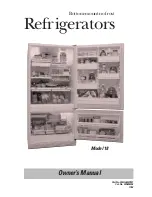
21
PERFORMANCE DATA SHEETS
Interior Water Filtration System
Model UKF8001AXX-750 Capacity 750 Gallons (2839 Liters)
This system has been tested according to NSF/ANSI Standards 42 and 53 for the reduction of the substances listed below. The
concentration of the indicated substances in water entering the system was reduced to a concentration less than or equal to the
permissible limit for water leaving the system, as specified in NSF/ANSI Standards 42 and 53.
Test Parameters: pH = 7.5 ± 0.5 unless otherwise noted. Flow = 0.78 gpm (2.9 Lpm). Pressure = 60 psig (413.7 kPa). Temp. = 68°F ± 5°F
(20°C ± 3°C).
■
It is essential that operational, maintenance, and filter
replacement requirements be carried out for the product to
perform as advertised.
■
The disposable water filter should be replaced at least every
6 months.
■
The filter monitor system measures the amount of water that
passes through the filter and alerts you to replace the filter.
When 90% of the filter’s rated life is used, the yellow (Order)
light comes on. When 100% of the filter’s rated life is used, the
red (Replace) light comes on, and it is recommended that you
replace the filter. For models without filter status lights,
replace the filter every 6 months. Use replacement filter
model UKF8001. 2014 suggested retail price of
$44.99 U.S.A./$49.95 Canada. Prices are subject to change
without notice.
■
The product is for cold water use only.
■
Do not use with water that is microbiologically unsafe or of
unknown quality without adequate disinfection before or after
the system. Systems certified for cyst reduction may be used
on disinfected waters that may contain filterable cysts.
■
Refer to the “Water Filtration System” section for the
Manufacturer’s name and telephone number.
■
Refer to the “Warranty” section for the Manufacturer’s limited
warranty.
Application Guidelines/Water Supply Parameters
System tested and certified by NSF International against NSF/ANSI Standard 42 for the
reduction of Chlorine Taste and Odor, Particulate Class I*; and against NSF/ANSI
Standard 53 for the reduction of Lead, Mercury, Atrazine, Benzene, p-Dichlorobenzene,
Carbofuran, Toxaphene, Cysts, Turbidity, Asbestos, Tetrachloroethylene and Lindane.
Substance Reduction
Aesthetic Effects
NSF Reduction
Requirements
Average
Influent
Influent Challenge
Concentration
Maximum
Effluent
Average
Effluent
Minimum%
Reduction
Average%
Reduction
Chlorine Taste/Odor
Particulate Class I
*
50% reduction
85% reduction
2.00 mg/L
14,000,000 #/mL
2.0 mg/L ± 10%
At least 10,000
particles/mL
0.06 mg/L
370,000 #/mL
**
0.050625 mg/L
196,666 #/mL
97.00%
97.40%
97.52%
99.00%
Contaminant
Reduction
NSF Reduction
Requirements
Average
Influent
Influent Challenge
Concentration
Maximum
Effluent
Average
Effluent
Minimum%
Reduction
Average%
Reduction
Lead: @ pH 6.5
Lead: @ pH 8.5
0.010 mg/L
0.010 mg/L
0.150 mg/L
†
0.150 mg/L
†
0.15 mg/L ± 10%
0.15 mg/L ± 10%
< 0.001 mg/L
< 0.001 mg/L
< 0.001 mg/L
< 0.001 mg/L
>99.30%
>99.30%
>99.30%
>99.30%
Mercury: @ pH 6.5
Mercury: @ pH 8.5
0.002 mg/L
0.002 mg/L
0.006 mg/L
0.0059 mg/L
0.006 mg/L ± 10%
0.006 mg/L ± 10%
0.0005 mg/L
0.0018 mg/L
0.0003 mg/L
0.00073 mg/L
91.70%
69.20%
95.00%
88.10%
Benzene
0.005 mg/L
0.0133 mg/L
0.015 mg/L ± 10%
0.0005 mg/L
0.0005 mg/L
96.10%
96.30%
p-Dichlorobenzene
0.075 mg/L
0.210 mg/L
0.225 mg/L ± 10%
< 0.0005 mg/L
< 0.0005 mg/L
>99.80%
>99.80%
Carbofuran
0.040 mg/L
0.0753 mg/L
0.08 mg/L ± 10%
0.027 mg/L
0.008 mg/L
64.60%
73.45%
Toxaphene
0.003 mg/L
0.015 mg/L
0.015 ± 10%
< 0.001 mg/L
< 0.001 mg/L
>93.3%
>93.3%
Atrazine
0.003 mg/L
0.0102 mg/L
0.009 mg/L ± 10%
0.0027 mg/L
0.00105 mg/L
76.30%
89.40%
Asbestos
>99%
126.5 MF/L
10
7
to 10
8
fibers/L
††
< 0.17 MF/L
< 0.17 MF/L
>99.99%
>99.99%
Live Cysts
‡
Turbidity
>99.95%
0.5 NTU
122,500 #/L
10.5 NTU
50,000/L min.
11 ± 1 NTU
< 1 #/L
‡
0.30 NTU
< 1 #/L
‡
0.125 NTU
>99.99%
97.30%
>99.99%
98.80%
Lindane
0.0002 mg/L
0.0019 mg/L
0.002 ± 10%
< 0.00016 mg/L
0.000035 mg/L
91.80%
97.90%
Tetrachloroethylene
0.005 mg/L
0.015 mg/L
0.015 mg/L ± 10%
< 0.0005 mg/L
< 0.0005 mg/L
>96.6%
>96.6%
Water Supply
Water Pressure
Water Temperature
Service Flow Rate
City or Well
35 - 120 psi (241 - 827 kPa)
33° - 100°F (1° - 38°C)
0.78 gpm (2.9 L/min.) @ 60 psi
*
**
†
††
‡
Class I particle size: >0.5 to <1 um
Test requirement is at least 100,000 particles/mL of AC Fine Test Dust.
These contaminants are not necessarily in your water supply. Performance may vary based on local water conditions.
Fibers greater than 10 um in length
Based on the use of Cryptosporidium parvum oocysts
® NSF is a registered trademark of NSF International.



































